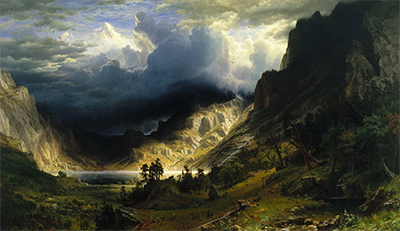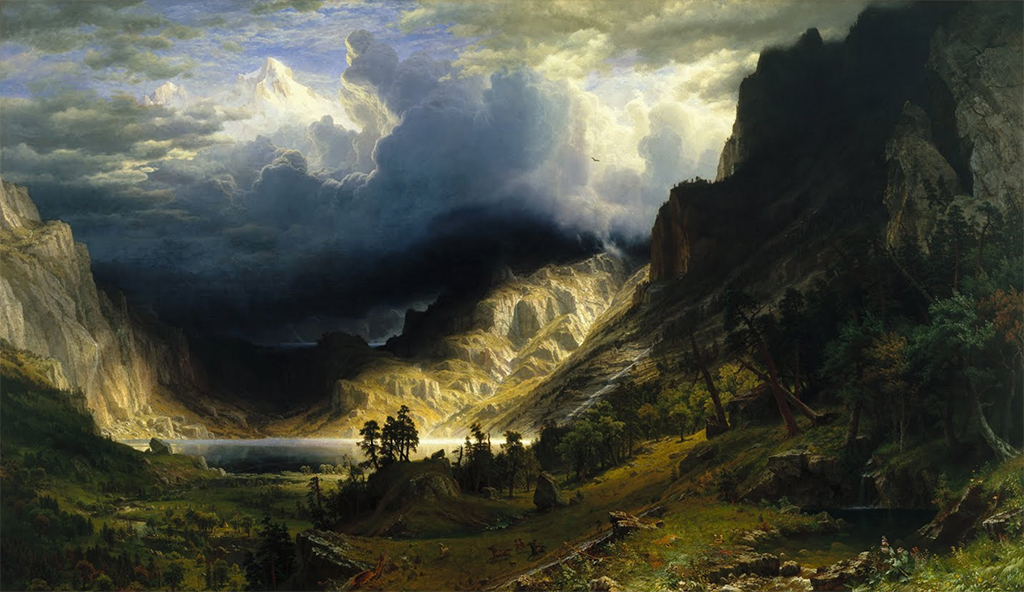This magnificent oil on canvas painting, titled Storm in the Rocky Mountains, was completed in 1866 by Albert Bierstadt.
A huge painting, measuring approximately twelve feet by seven, it took Bierstadt three years to complete it in his New York studio. Bierstadt was quite adept at using publicity and invited newspaper reporters along to his studio to report on the progress of the painting. When it was finally ready, he unveiled it with his usual showmanship, selling tickets to a theatrical style unveiling. The proceeds from the first exhibition of the painting at the Somerville Art Gallery in New York City were donated to a children's hospital in New York.
The single painting was then taken on tour across the major US cities and to Europe, where many prospective settlers would be in awe of the spectacular image of this new country and keen to see any images of America. In 1967 it was paired with The Rocky Mountains painting for Queen Victoria's private viewing at Osborne House. Here, Bierstadt sat and conversed with the Queen about art. The painting was relatively well received, although one critic called it "large and showy". It sold for around twenty thousand dollars to an English Railroad Magnate by the name of Thomas William Kennard.
Storm in the Rocky Mountains is a spectacular image and captivates viewers today, just as it did when Bierstadt unveiled it. Bierstadt painted in the Hudson River School style of art. His grand landscapes are romanticized and filled with his own idyllic vision. Bierstadt had made sketches of the Rocky Mountains and local area whilst on expedition in 1963, but he chose to emphasize and exaggerate the scale of the mountains and which landmarks to depict. This painting also shows how Bierstadt was a master of luminism, using the light in this picture to dramatic effect, creating an eerie, almost spiritual atmosphere.
Storm in the Rocky Mountains depicts Mount Evans, the highest peak in the front range peaks of the Rocky Mountains near Denver, Colorado, North America. The peak, which can be seen breaking though the cloud at the top of the painting was not named at the time. Bierstadt called it Mount Rosalie, after Rosalie, the wife of Fritz Hugh Ludlow. Ludlow was an art critic for the New York Evening Post and had accompanied Bierstadt on some of his travels to the region. As Ludlow grew more addicted to cannabis and other substances, Rosalie became Bierstadt's mistress. When she finally obtained a divorce in May 1866, Rosalie married Bierstadt soon after.
The painting can be appreciated as a panoramic, expansive view of the wilderness but as the viewer begins to study it more closely, more and more minute details are revealed, which is characteristic of Bierstadt's paintings. Bierstadt has chosen to give the viewer a "bird's eye view" of this majestic scene. The peak at the top of the painting is Bierstadt's Mount Rosalie. It is almost white and appears as if in a spotlight. Just below the peak and to the left of the painting, dark, dramatic storm clouds are gathering.
Across to the right, Bierstadt has painted an eagle soaring across the clouds, the eagle being a symbol of America. Just below the dark clouds is a lake. Moving down to the foreground of the painting a river runs into the main lake, which is depicted at the centre of the painting. Beside this river is an encampment of teepees. Across to the left of the painting, Bierstadt has painted some native American Indians, one on horseback and two on foot with a dog. They appear to be chasing two horses. Some critics have suggested that Bierstadt deliberately chose to depict these native American Indians as tiny figures to emphasise the "Manifest Destiny" of America.
At that time, there was a belief that the expansion of this new young country was inevitable. Yet as time moved on, the Hudson River School painters and others realized that "progress" came at a huge cost to these beautiful, remote areas and to the indigenous people and their way of life. Perhaps Bierstadt was aware of the future that would eventually impact upon the native American Indians here. To the left of the painting, the scene is dominated by the huge mountains. Bierstadt plays with the light upon the waterfalls which run down the rocks. He fills the foreground with wonderful detail of the pines, aspens, grasses and other wild flora.
A couple of the trees show nature's imperfection, one is uprooted and beginning to fall. Bierstadt's incredible detail engages the viewer, encouraging them to study the scene carefully, delighting in all the tiny "discoveries" like the camp fire, deer, saddle and blanket left by the hunters in the foreground at the bottom right of the picture. Storm in the Rocky Mountains is now held at the Brooklyn Museum in America. It is an incredible scene of an untamed America and an image which never ceases to amaze and engage the viewers.





